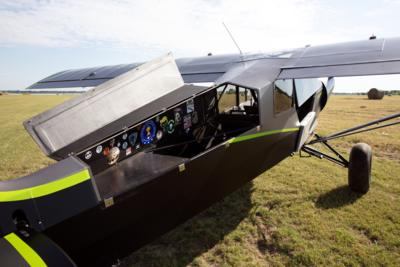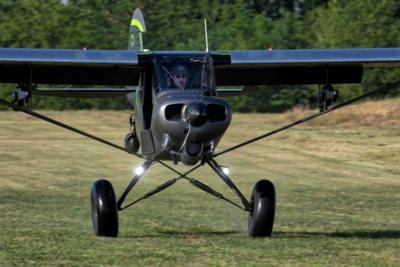In Consideration of American Legend’s MOAC: One of the 1000+ SportPlane Profiles Destined For The Next SportPlane Resource Guide
E-I-C Note: The eSPRG and ANN staff have been working furiously, behind the scenes on a new All-Digital, Next-Generation, SportPlane Resource Guide.

In addition to nearly 100 'How-To' chapters, dozens of appendices, THOUSANDS of videos and images, and other fonts of SportPlane knowledge, we estimate that some 1000 or so SportPlanes and Sport Aircraft will eventually be profiled. Herewith; a sample profile of one of the many, many, MANY aircraft coming up for the next eSPRG... while also noting that the published eSPRG profiles will also include even more info, pictures, data and (where possible) detailed and carefully critical Report Cards detailing the capabilities and suitability of the manufacturer and the aircraft in question. We have a massive job ahead of us... and the first few hundred pages, of the 2000 or so that we expect to publish online, will hit the AeroVerse in just a few weeks... Don't miss them! YOUR suggestions and comments about this, and other concepts and formats, planned for the eSPRG are not only welcomed, but STRONGLY encouraged... after all, we're doing this for YOU... the current and future SportPlane reader,
owner, builder, and pilot.
Designed by Clarence Gilbert Taylor in the early 1930s, the aircraft history, aviation purists, and untold volumes of yellow paint have immortalized as the Piper J-3 Cub has occasioned affection, nostalgia, and knockoffs in equal measure. Excepting the Swingline stapler, Bic Cristal pen, and Pyrex measuring cup, few designs have been so repeatedly and lovingly emulated.

Asked to draw a small airplane, an eight-year-old boy would likely turn out a fair rendering of Piper’s iconic machine—a high-wing, strut-braced monoplane with a large-area rectangular wing. The lad may or may not accurately depict the J-3 Cub’s air-cooled, flat-4 piston engine; two-blade, fixed-pitch propeller; fabric-over-welded-steel-fuselage; or tandem seating arrangement—but his rendering would have fidelity enough to be eminently distinguishable.
Asked to draw a small airplane thirty-years and a few advanced degrees in aeronautical engineering later, the same eight-year-old boy might well push aside his beer, boot up his SharkCAD Pro software, and crank out a 3D rendering of Legend Cub’s American Legend MOAC—a fire-breathing iteration of the company’s AL3 J-3 clone sporting a plethora of lift-inducing wizardry, big beefy landing gear and tundra-tires, and powered by a version of Continental’s XP-370 Titan engine normally rated at 195-horsepower, but capable of producing 208-snorting ponies on takeoff.
An acronym standing for Mother Of All Cubs, MOAC accurately and succinctly describes the airplane American Legend called: “… the most exciting way to fly low and slow while driving performance to the extreme.”

Capable of taking off within its own fuselage length, the MOAC is a hot-rodder’s dream. The aircraft’s wings sport a riot of lift-augmentations, to include three-hinge flaps extendable to forty-degrees, automatic leading-edge slats, and vortex generators. The slats, on each wing, comprise two sections: outboard and middle-board. The devices’ inboard ends run not to the edge of the fuselage, but rather to the periphery of the tractor propeller’s prop-wash. Vortex generators originally covered the proximal aspect of the MOAC’s wing; American Legend engineers, however, realized performance benefits by allowing the slats to operate only in the clear air outside the propeller’s wake.
The MOAC’s TKI Racing undercarriage features a Shock Monster nitrogen charged air/oil shock assembly. Designed for the harshest of bush flying zones, the oil-dampened system, upon compression, capably dissipates the landing aircraft’s vertical kinetic energy. A dual shock setup delivers the security of redundancy, outstanding cushioning, and zero bounce-back. The MOAC’s shock-absorber travel of 4.5-inches equates to about 12–14 inches at the wheel—so states American Legend.
The MOAC can be purchased as a Special Light-Sport Aircraft (S-LSA) with some limitations on performance. The aircraft can also be built as an Experimental Light-Sport Aircraft (E-LSA) by the American Legend factory—or as an Experimental/Amateur-Built (EAB). The latter option may be exercised via the American Legend’s factory-assist program, or by having the aircraft kit and components shipped directly to the builder’s workshop.
Viewed through the clear but narrow lenses of specifications and limitations, the MOAC presents a number of seemingly disparate aspects, the aggregation of which gives rise to a surprising and desirable aircraft.

The MOAC’s in-flight airspeed envelope is bordered, top-and-bottom, by a 22-knot Vso stall speed and a 111-knot Vne. Cleanly configured at its EAB maximum gross weight of two-thousand-pounds, the airplane stalls at 28-knots. The MOAC claims a takeoff ground roll of sixty-feet, and a sea-level climb-rate of 1,900-feet-per-minute. Empty, the MOAC weighs 890-pounds. Two fuel capacities are offered: thirty and forty-gallons.
Equipped with the optional forty-gallon fuel-tanks, the MOAC manages 7.8-hours endurance at 75-percent cruise-power (91-knots).
After the fashion of all American Legend models, the MOAC’s service-ceiling is 15,000-feet.
Born of a U.S. Army project devised to test the notion that a souped-up Cub can, at times, prove a more practical and usable asset than a $15-million helicopter, American Legend’s MOAC is what the J-3 might have been, had it been designed jointly by Steve Henry, Travis Pastrana, and Evel Knievel.



 Bolen Gives Congress a Rare Thumbs-Up
Bolen Gives Congress a Rare Thumbs-Up The SportPlane Resource Guide RETURNS!!!!
The SportPlane Resource Guide RETURNS!!!! Buying Sprees Continue: Textron eAviation Takes On Amazilia Aerospace
Buying Sprees Continue: Textron eAviation Takes On Amazilia Aerospace Hawker 4000 Bizjets Gain Nav System, Data Link STC
Hawker 4000 Bizjets Gain Nav System, Data Link STC Echodyne Gets BVLOS Waiver for AiRanger Aircraft
Echodyne Gets BVLOS Waiver for AiRanger Aircraft









